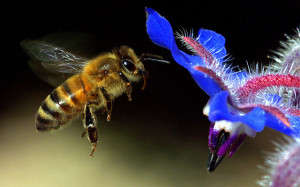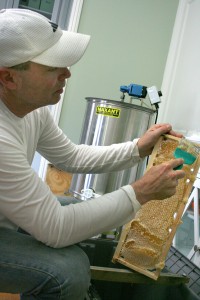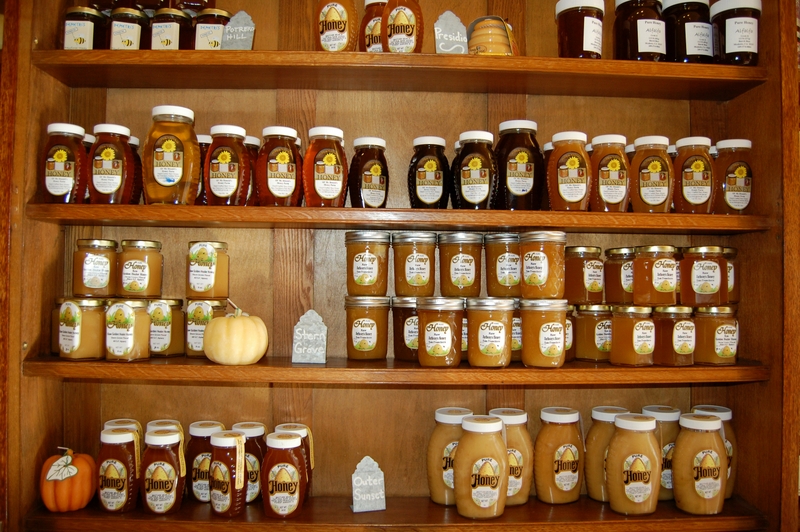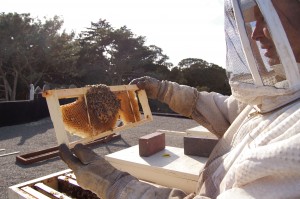Hidden on rooftops and tucked away in backyards, San Francisco’s honeybees have become part of the urban fabric, and are busier than most at this time of year, when bees elsewhere hunker down in their hives.
San Francisco’s mild climate allows honey production to be a year round enterprise for the busy bees, and that combined with lenient laws, a pesticide ordinance and green-minded residents have inadvertently made the city among the most welcoming for urban bees and their keepers.
Although many people don’t even know the bees are here, an active group of beekeepers is expanding the population and making San Francisco a worldwide hub in urban honey production whose bounty rivals, and may even exceed, other hotspots like New York, Paris and Tokyo.
In Part 2 in our mini-series on urban beekeeping, we explore how San Francisco has become a honeybee’s paradise. In Part 1 of Bay Nature’s mini-series on urban beekeeping, Thrill of the hive, we met Charlie Blevins, the president of the 180-member strong San Francisco Beekeepers Association, and the harvester of a whopping 500 pounds of honey a year.
A different tune
In places that experience chilly winter temperatures, honey bees forgo foraging and reproduction and form a dormant winter cluster within their hive. Huddling together around the queen, worker bees vibrate their bodies to generate temperatures of up to 94-degrees, feeding off their honey stocks until the spring brings warmer weather and blossoming flowers.

But like many of San Francisco’s residents, the honeybees here sing to a different tune. As long as temperatures crest 50-degrees and it’s not raining, honey bees are on the fly, hitting up winter blooms and laying eggs.
Ample winter nectar and mild temperatures also give San Francisco beekeepers an additional harvest or two; while most beekeepers only get two harvests a year, some Bay Area keepers, like Charlie Blevins (President of the San Francisco Beekeepers Association), get up to four.
Blevins, who harvested 500 pounds of honey last year, attributes his fecund winter harvest to the widespread blooms of Golden Gate Park’s eucalyptus trees. As the third most abundant tree in Golden Gate Park, the blue gum eucalyptus dominates the forest canopy as well as the winter blossoms. Honey bees are also drawn at this time of the year to the blue blossoms on rosemary bushes, which are sprinkled throughout the park.
Honey bees also reap the rewards of the San Francisco Botanical Garden’s winter-blooming flora, such as the towering tree daisies of the Mexican cloud forest collection or the purple, yellow, and white blossoms of the Mediterranean Christmas heather. Blooming each February, the native California lilac is also a favorite among honey bees.
“You can hear the noise from the bees 20 to 30 feet away. There are so many of them,” said Don Mahoney, curator of the botanical garden and an expert on gardening for bees.
Since spring and summer bring many more foraging options for honey bees, it’s nearly impossible to know what exactly they are eating during warmer months.
You are what you eat
The healthy harvest could also have to do with healthy city bees, which have little exposure to lethal pesticides. In 1996, San Francisco enacted a strict pesticide ordinance, phasing out nearly all pesticide use on city parks and buildings.
“Any big city will have pesticides, but compared to other cities, people in San Francisco don’t use as much. People are more organically-minded here,” said Blevins.

Ingested through the pollen, pesticides can assimilate into a bee’s bodily tissues and disrupt its biochemistry to put them into a weakened and vulnerable state.
“Pesticides definitely stress bees out and very well make them more susceptible to the next thing,” said Eric Mussen, Extension Apiculturist at UC Davis.
It’s still not clear, however, what level of pesticide exposure is toxic to bees.
More recently, contact pesticides, which control pests through direct contact with the chemicals, are being replaced by systemic pesticides, in which chemicals are absorbed by the plant rather than merely coating it. Mussen worries that some of the systemic toxicants may find their way into the fruits, flowers, and nectar of affected plants, and go on to hurt bees.
Unlike pollen, nectar is not ingested by bees, but rather stored in a pouch-like structure in the bee’s digestive system called the crop. Once back at the hive, bees regurgitate the nectar, mix it with enzymes, and deposit it in a cell in the comb, which later becomes honey. If pesticides are present in nectar, these chemicals may migrate back to the honeycomb and cling to beeswax, later to get bound up in the bees’ bodies. Surprisingly honey tends to be free of pesticide residues, says Mussen.
Although many of San Francisco’s bees may avoid exposure to pesticides, other urban bees aren’t as lucky. For example, more than a quarter of New York City’s available land is occupied by public parks, playgrounds, nature preserves, and golf courses, all of which are all subject to the city’s widespread use of Monsanto’s Roundup, a systemic herbicide. Considering that the Big Apple’s beekeeping scene has recently taken flight, with major hotels like the Waldorf-Astoria adopting rooftop beekeeping to stay atop of latest trends, it’s easy to imagine that many New York bees have few choices beyond pesticide-laced nectar and pollen.
Lenient laws
Beekeeping’s popularity in San Francisco is also fostered by the city’s lenient laws, which make it easy for beekeeping clubs to quickly grow. The San Francisco Beekeepers Association has 180 members, all of whom own at least one hive if not five. Anyone in San Francisco can keep bees as long as the bees do not become a public nuisance.
But the beekeeping scene would never have come so far if it weren’t for the interest and passion among locals, many of whom found their way to beekeeping through organic gardening and urban agriculture.

Christian Riechert, manager of America’s first urban beekeeping supply store, Her Majesty’s Secret Beekeeper (HMSB), based in the Mission, said he found it easy to go from organic farming to beekeeping. Today Christian leads community-building beekeeping programs throughout the Bay Area, such as HMSB’s “Pairing Program” in which he matches urban beekeepers in need of spots for their hives, with bee enthusiasts who have the space but not the ability. (The HMSB storefront recently closed down, but the online store still appears active)
Additionally, SF BeeCause is one of many local organizations that pollinates the Bay Area with programs that combine bees with community development. Inspired by Sweet Beginnings in Chicago, a workforce development program that trains newly-released prisoners in apiculture, SF BeeCause is applying a similar model in San Francisco. Running “bee farms” in places like Hayes Valley and Glen Park, the organization provides transitional work experience and volunteer opportunities in apiculture, and trains beekeepers. The honey ends up at local organizations, like the Neighbors Developing Divisadero, which uses proceeds from honey drives to create sustainable community development programs.
While honey bee numbers are still down since colony collapse disorder hit in 2006, the rise in urban beekeeping is not only helping bees rebound, but has also bolstered local flora and fauna.
“Bee populations are slowly improving because [urban beekeepers] are providing a better place for bees,” said Blevins.
He believes recovering bee populations are one of the reasons why Golden Gate Park is flush with life.






-300x225.jpg)
-300x199.jpg)